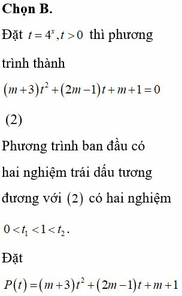Tìm tất cả các giá trị của tham số m để phương trình ( m + 3 ) 16 x + ( 2 m - 1 ) 4 x + m + 1 = 0 có hai nghiệm trái dấu
![]()
![]()
![]()
![]()
Hãy nhập câu hỏi của bạn vào đây, nếu là tài khoản VIP, bạn sẽ được ưu tiên trả lời.




1.
Đặt \(\sqrt{x^2-4x+5}=t\ge1\Rightarrow x^2-4x=t^2-5\)
Pt trở thành:
\(4t=t^2-5+2m-1\)
\(\Leftrightarrow t^2-4t+2m-6=0\) (1)
Pt đã cho có 4 nghiệm pb khi và chỉ khi (1) có 2 nghiệm pb đều lớn hơn 1
\(\Leftrightarrow\left\{{}\begin{matrix}\Delta'=4-\left(2m-6\right)>0\\\left(t_1-1\right)\left(t_2-1\right)>0\\\dfrac{t_1+t_2}{2}>1\\\end{matrix}\right.\)
\(\Leftrightarrow\left\{{}\begin{matrix}10-2m>0\\t_1t_2-\left(t_1+t_1\right)+1>0\\t_1+t_2>2\end{matrix}\right.\)
\(\Leftrightarrow\left\{{}\begin{matrix}m< 5\\2m-6-4+1>0\\4>2\end{matrix}\right.\) \(\Leftrightarrow\dfrac{9}{2}< m< 5\)
2.
Để pt đã cho có 2 nghiệm:
\(\Leftrightarrow\left\{{}\begin{matrix}m\ne3\\\Delta'=1+4\left(m-3\right)\ge0\end{matrix}\right.\)
\(\Leftrightarrow\left\{{}\begin{matrix}m\ne3\\m\ge\dfrac{11}{4}\end{matrix}\right.\)
Khi đó:
\(x_1^2+x_2^2=4\Leftrightarrow\left(x_1+x_2\right)^2-2x_1x_2=4\)
\(\Leftrightarrow\dfrac{4}{\left(m-3\right)^2}+\dfrac{8}{m-3}=4\)
\(\Leftrightarrow\dfrac{1}{\left(m-3\right)^2}+\dfrac{2}{m-3}-1=0\)
\(\Leftrightarrow\left[{}\begin{matrix}\dfrac{1}{m-3}=-1-\sqrt{2}\\\dfrac{1}{m-3}=-1+\sqrt{2}\end{matrix}\right.\)
\(\Leftrightarrow\left[{}\begin{matrix}m=4-\sqrt{2}< \dfrac{11}{4}\left(loại\right)\\m=4+\sqrt{2}\end{matrix}\right.\)

a: Khi m=1 thì (1): x^2-2(1-2)x+1^2-5-4=0
=>x^2+2x-8=0
=>(x+4)(x-2)=0
=>x=2 hoặc x=-4
b: Δ=(2m-4)^2-4(m^2-5m-4)
=4m^2-16m+16-4m^2+20m+16
=4m+32
Để pt có hai nghiệm phân biệt thì 4m+32>0
=>m>-8
x1^2+x2^2=-3x1x2-4
=>(x1+x2)^2+x1x2+4=0
=>(2m-4)^2+m^2-5m-4+4=0
=>4m^2-16m+16+m^2-5m=0
=>5m^2-21m+16=0
=>(m-1)(5m-16)=0
=>m=16/5 hoặc m=1

ĐKXĐ: \(x\ne1;x\ne-2\)\(\Rightarrow\left(2x-m\right)\left(x+2\right)+\left(x+1\right)\left(x-1\right)=3\left(x-1\right)\left(x+2\right)\Leftrightarrow2x^2+4x-mx-2m+x^2-1=3x^2+3x-6\Leftrightarrow3x^2+4x-mx-2m-3x^2-3x=-6\) \(\Leftrightarrow x-mx=2m-6\Leftrightarrow x\left(1-m\right)=2m-6\Leftrightarrow x=\dfrac{2m-6}{1-m}\)
\(\Rightarrow\) Để pt có nghiệm \(\Leftrightarrow m\ne1\) Vậy...

a) thay m=-1 vào pt(1) có : (-1+1)x2 -(2.1+3)x+1+4=0
\(\Leftrightarrow-5x+5=0\)
\(\Leftrightarrow-5.\left(x-1\right)=0\)
\(\Leftrightarrow x=1\)
vậy ....
b) ĐK pt(1) : m+1\(\ne0\)\(\Leftrightarrow m\ne-1\)
\(\Delta=b^2-4ac=[-\left(2m+3\right)]^2-4.\left(m+1\right).\left(m+4\right)\)
........

Để bất phương trình luôn có nghiệm thì
\(\left\{{}\begin{matrix}\left(m-1\right)^2-4\cdot1\cdot5< 0\\1>=0\end{matrix}\right.\Leftrightarrow\left(m-1\right)^2< 20\)
\(\Leftrightarrow-2\sqrt{5}+1< x< 2\sqrt{5}+1\)

Ta có: m(x - 1) < 3 – x

Bất phương trình tương đương là ( m + 1 )x < m + 3
Rõ ràng với m ≠ - 1 thì bất phương trình luôn có nghiệm
Với m = - 1 ta có bất phương trình có dạng: 0x < 2 luôn đúng với mọi x
Vậy bất phương trình có nghiệm với mọi m.
Chọn đáp án C.